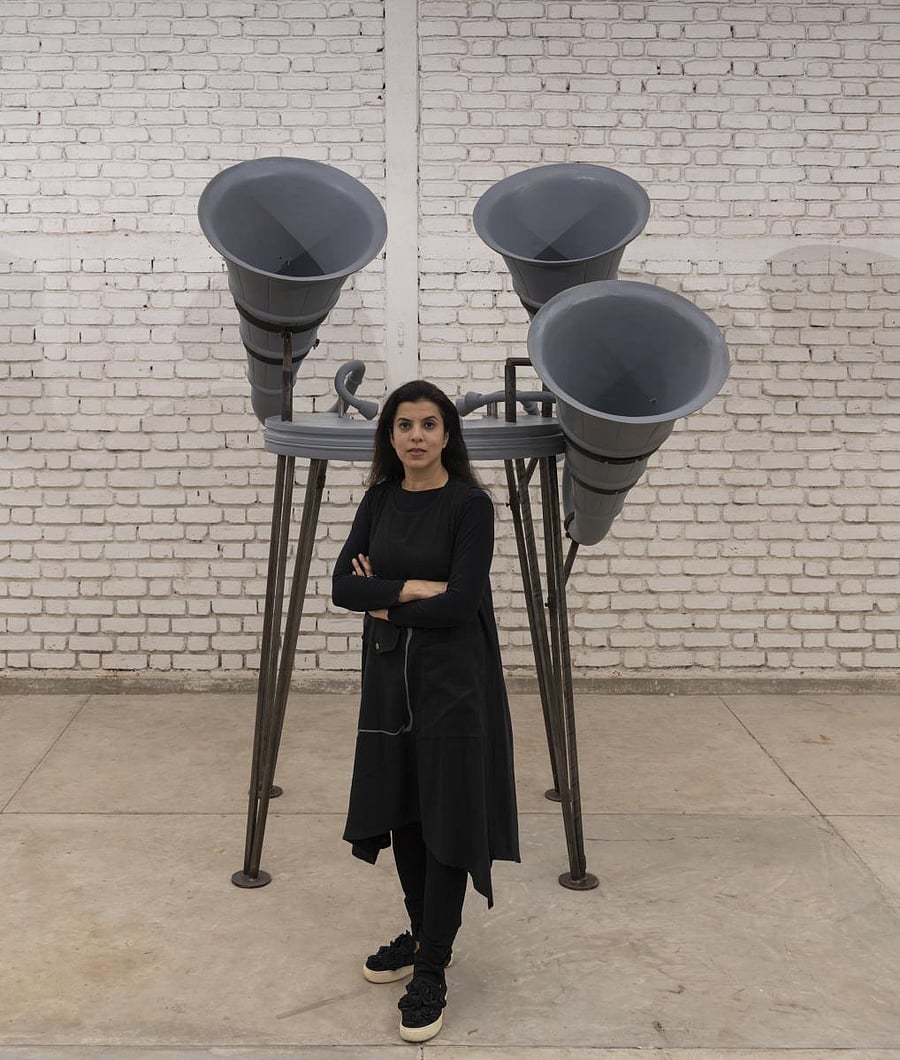
She makes a viewer reflect. Her works very cleverly force you to initiate a dialogue with yourself. Standing in front of a large wall before ten works of art in a row, looking at the thick dark lines separating two landmasses covered by an electric wire mesh, makes you contemplate the turbulence of history and the current state of affairs in the world. Time stands still when you look at the series of ‘Leaking Line’, describing conflicts and man-made boundaries — the Durand line (between Afghanistan-Pakistan), the McMahon line (between the Tibetan region of China and the north-eastern region of India), the Green line (demarcation between Israel and Palestine) and seven other such border lines.
One needn’t know the historical events of these works. Every work has two sections — one half has the archival images of sites showing the violent histories of those places now separated by man-made borders.It’s accompanied by a beautifully handwritten text explaining the event. The second part is her interpretation of the event with dark lines and the mesh.
The ‘Cleft’ is another striking work. It is a huge central canvas depicting the turmoil in nature and the catastrophic effect it’s having on us. A large canvas of hybrid flora and fauna, animals, rivers and landscapes desperately urging people to reset the planet divided by us, human beings.
Man-made incisions
“I have always been intrigued by the man-made incisions on the ground, which decide the fate of citizens on either side of the border and the implications to their lives. These unseen lines or borders, be it between two states, countries, mountains or even water bodies may be politically constructed, but what interests me is the creation of psychological and social barriers between people by these innocuous-looking borders,” explains Mumbai-based multi-media artist Reena Saini Kallat, explaining the concept behind her work titled ‘Blind Spots’, recently exhibited at the Chemould Prescott Road art gallery in Mumbai.
A viewer who prefers to look at very colourful figurative paintings with simple figures of animals, flora and fauna or human beings, may find Reena’s art very confusing. Her works, which include drawings, photographs, sculptures, video and audio, tell us about real issues happening across the world. She very boldly questions the ideas of borders, geography, landscape, identity, memory, history and the natural world.
Take for example the series clubbed under the title ‘Shifting Ecotone-2’. Here, she has taken the pictures of various rivers and seas from all over the world whose waters are shared by two, sometimes three countries. She takes the digital prints of these rivers for reference, draws and paints, giving her own style of interpretation and divides the images into several square pieces like a jigsaw puzzle.
“Many countries share river waters with each other; for example, India shares famous rivers like Chenab, Sutlej, Beas, Indus, Teesta, Ganga, Brahmaputra and so many others with Pakistan and Bangladesh. The borders separate the lands into two different nations, but these rivers, despite the barbed wire on the borders, continue to flow unhindered between the two countries. The biodiversity around it proliferates in the same way. What if these rivers changed course? How do different countries respond to the same river is something I have always wondered!” says Reena.
It’s this unique representation of thoughts that has been welcomed by several national and international institutes (Museum of Modern Art, New York, Art Gallery of New South Wales Sydney, Tate Modern London, Mori Art Museum Tokyo and several others), where she has had opportunities to display her works.
Her latest exhibition ‘Blind Spots’ is, in a way, a continuation of her previous exhibition titled Hyphenated lives (2015, Mumbai), which was a re-imagining of the natural world of animals and trees. A hyphen is used to unify the landmasses demarcated with imaginary lines.
In fact, in ‘Blind Spots’, to emphasise the commonalities between different countries, she has an audio-visual installation, which deploys the preambles of the Constitutions of seven pairs of warring nations. In all these Constitutions, the warring countries share many common elements and words. Here, Reena alludes to the metaphor of having lost sight of the values and aspirations that are common to both nations. She urges the audience to reflect back on the promises that have slipped from collective memory.